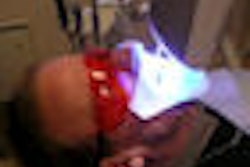Exposure to ultraviolet (UV) light puts tissues in the oral cavity at a much higher carcinogenic risk than skin tissue, according to a study in Photochemistry and Photobiology (July 15, 2013).
People can expose their oral cavities to UV radiation simply by opening their mouths while outdoors, noted the study authors, from the U.S. Food and Drug Administration's Center for Devices and Radiological Health. Oral cavities can also be exposed to UV via UV-emitting devices used for diagnosis, treatment, and procedures such teeth whitening.
To understand the UV-related carcinogenic risks to these tissues, the researchers measured initial DNA damage in the form of cyclobutane pyrimidine dimers (CPD), the repair rate of CPD (24 hours), and the number of apoptotic dead cells over time. They used commercially available 3D-engineered models of human skin, gingival, and oral tissues and a trilabeling fluorescent procedure to identify total DNA, CPD, and apoptotic cells.
They found that both DNA repair and apoptotic cell numbers are significantly lower in oral cells comparedwith skin cells.
The results suggest that UV-exposed oral tissues are at a significantly higher carcinogenic risk than skin tissues, the study authors concluded.



















